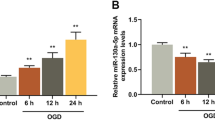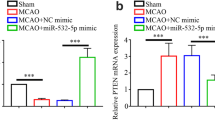Abstract
Ischemic stroke is a serious disease with limited prevention methods, and various genes and microRNAs (miRNAs) have been found to be dysregulated in the pathogenesis of this disease. This study aims to explore the potential role of miR-381-3p in ischemic stroke, along with its underlying mechanism. A mouse model of ischemic stroke was developed using middle cerebral artery occlusion. Next, the expression of mitogen-activated protein kinase kinase kinase 8 (Map3k8) and CCAAT enhancer binding protein beta (Cebpb) was determined by RT-qPCR. Gain- and loss-of-function approaches were applied to analyze the effects of miR-381-3p, Cebpb and Map3k8 on the biological functions of endothelial progenitor cells (EPCs) with the involvement of the tumor necrosis factor-α (TNF-α) signaling pathway. In addition, dual luciferase reporter gene assay was performed for the analysis of the relationship among miR-381-3p, Map3k8 and Cebpb. Further, rescue experiment was performed with the help of JNK/p38 specific agonist, Anisomycin. Map3k8 and Cebpb were highly expressed in ischemic stroke. Loss-of-function of Map3k8 or Cebpb in EPCs contributed to accelerated proliferation, migration and angiogenesis of EPCs. Next, miR-381-3p downregulated the expression of its two target genes, Map3k8 and Cebpb. miR-381-3p overexpression promoted angiogenesis of EPCs, and inhibited inflammation, which could be reversed by restoration of Map3k8 or Cebpb. Additionally, silencing Map3k8 or Cebpb inhibited the activation of TNF-α signaling pathway. Furthermore, Anisomycin treatment could enhance inflammation and inhibit angiogenesis. Taken together, miR-381-3p downregulates Map3k8 and Cebpb to protect against ischemic stroke, broadening our understanding of the pathogenesis of ischemic stroke.






Similar content being viewed by others
Data Availability
The datasets generated during the current study are available from the corresponding author on reasonable request.
References
Adlakha YK, Seth P (2017) The expanding horizon of MicroRNAs in cellular reprogramming. Prog Neurobiol 148:21–39
Boehme AK, Esenwa C, Elkind MS (2017) Stroke risk factors, genetics, and prevention. Circ Res 120:472–495
Campbell BC, Mitchell PJ, Kleinig TJ, Dewey HM, Churilov L, Yassi N, Yan B, Dowling RJ, Parsons MW, Oxley TJ, Wu TY, Brooks M, Simpson MA, Miteff F, Levi CR, Krause M, Harrington TJ, Faulder KC, Steinfort BS, Priglinger M, Ang T, Scroop R, Barber PA, McGuinness B, Wijeratne T, Phan TG, Chong W, Chandra RV, Bladin CF, Badve M, Rice H, de Villiers L, Ma H, Desmond PM, Donnan GA, Davis SM, Investigators E-I (2015) Endovascular therapy for ischemic stroke with perfusion-imaging selection. N Engl J Med 372:1009–1018
Chen WC, Luo J, Cao XQ, Cheng XG, He DW (2018) Overexpression of miR-381-3p promotes the recovery of spinal cord injury. Eur Rev Med Pharmacol Sci 22:5429–5437
Dong L, Li H, Zhang S, Yang G (2019) miR148 family members are putative biomarkers for sepsis. Mol Med Rep 19:5133–5141
Feigin VL, Norrving B, Mensah GA (2017) Global burden of stroke. Circ Res 120:439–448
Goyal M, Demchuk AM, Hill MD (2015) Endovascular therapy for ischemic stroke. N Engl J Med 372:2366
Griggs RB, Donahue RR, Morgenweck J, Grace PM, Sutton A, Watkins LR, Taylor BK (2015) Pioglitazone rapidly reduces neuropathic pain through astrocyte and nongenomic PPARgamma mechanisms. Pain 156:469–482
Hammam O, Mahmoud O, Zahran M, Sayed A, Salama R, Hosny K, Farghly A (2013) A possible role for TNF-alpha in coordinating inflammation and angiogenesis in chronic liver disease and hepatocellular carcinoma. Gastrointest Cancer Res 6:107–114
Hankey GJ (2013) Dual antiplatelet therapy in acute transient ischemic attack and minor stroke. N Engl J Med 369:82–83
Kapadia R, Tureyen K, Bowen KK, Kalluri H, Johnson PF, Vemuganti R (2006) Decreased brain damage and curtailed inflammation in transcription factor CCAAT/enhancer binding protein beta knockout mice following transient focal cerebral ischemia. J Neurochem 98:1718–1731
Karakas M, Zeller T (2017) A biomarker ocular: circulating MicroRNAs toward diagnostics for acute ischemic stroke. Circ Res 121:905–907
Kim T, Mehta SL, Morris-Blanco KC, Chokkalla AK, Chelluboina B, Lopez M, Sullivan R, Kim HT, Cook TD, Kim JY, Kim H, Kim C, Vemuganti R (2018) The microRNA miR-7a-5p ameliorates ischemic brain damage by repressing alpha-synuclein. Sci Signal 11:eaat4285
Lambertsen KL, Finsen B, Clausen BH (2019) Post-stroke inflammation-target or tool for therapy? Acta Neuropathol 137:693–714
Li YF, Ren LN, Guo G, Cannella LA, Chernaya V, Samuel S, Liu SX, Wang H, Yang XF (2015) Endothelial progenitor cells in ischemic stroke: an exploration from hypothesis to therapy. J Hematol Oncol 8:33
Li G, Morris-Blanco KC, Lopez MS, Yang T, Zhao H, Vemuganti R, Luo Y (2018) Impact of microRNAs on ischemic stroke: from pre- to post-disease. Prog Neurobiol 163–164:59–78
Liu F, Chen N, Xiao R, Wang W, Pan Z (2016) miR-144-3p serves as a tumor suppressor for renal cell carcinoma and inhibits its invasion and metastasis by targeting MAP3K8. Biochem Biophys Res Commun 480:87–93
Liu L, Yao J, Li Z, Zu G, Feng D, Li Y, Qasim W, Zhang S, Li T, Zeng H, Tian X (2018) miR-381-3p knockdown improves intestinal epithelial proliferation and barrier function after intestinal ischemia/reperfusion injury by targeting nurr1. Cell Death Dis 9:411
Mao L, Li P, Zhu W, Cai W, Liu Z, Wang Y, Luo W, Stetler RA, Leak RK, Yu W, Gao Y, Chen J, Chen G, Hu X (2017) Regulatory T cells ameliorate tissue plasminogen activator-induced brain haemorrhage after stroke. Brain 140:1914–1931
Navarro-Sobrino M, Rosell A, Hernandez-Guillamon M, Penalba A, Ribo M, Alvarez-Sabin J, Montaner J (2010) Mobilization, endothelial differentiation and functional capacity of endothelial progenitor cells after ischemic stroke. Microvasc Res 80:317–323
Nazarov PV, Reinsbach SE, Muller A, Nicot N, Philippidou D, Vallar L, Kreis S (2013) Interplay of microRNAs, transcription factors and target genes: linking dynamic expression changes to function. Nucleic Acids Res 41:2817–2831
Rahman SM, Janssen RC, Choudhury M, Baquero KC, Aikens RM, de la Houssaye BA, Friedman JE (2012) CCAAT/enhancer-binding protein beta (C/EBPbeta) expression regulates dietary-induced inflammation in macrophages and adipose tissue in mice. J Biol Chem 287:34349–34360
Rayner KJ, Suarez Y, Davalos A, Parathath S, Fitzgerald ML, Tamehiro N, Fisher EA, Moore KJ, Fernandez-Hernando C (2010) MiR-33 contributes to the regulation of cholesterol homeostasis. Science 328:1570–1573
Roos AB, Barton JL, Miller-Larsson A, Dahlberg B, Berg T, Didon L, Nord M (2012) Lung epithelial-C/EBPbeta contributes to LPS-induced inflammation and its suppression by formoterol. Biochem Biophys Res Commun 423:134–139
Ruan W, Li J, Xu Y, Wang Y, Zhao F, Yang X, Jiang H, Zhang L, Saavedra JM, Shi L, Pang T (2019) MALAT1 up-regulator polydatin protects Brain microvascular integrity and ameliorates stroke through C/EBPbeta/MALAT1/CREB/PGC-1alpha/PPARgamma pathway. Cell Mol Neurobiol 39:265–286
Sanz-Garcia C, Ferrer-Mayorga G, Gonzalez-Rodriguez A, Valverde AM, Martin-Duce A, Velasco-Martin JP, Regadera J, Fernandez M, Alemany S (2013) Sterile inflammation in acetaminophen-induced liver injury is mediated by Cot/tpl2. J Biol Chem 288:15342–15351
Senger K, Pham VC, Varfolomeev E, Hackney JA, Corzo CA, Collier J, Lau VWC, Huang Z, Hamidzhadeh K, Caplazi P, Peng I, Setiadi AF, Francis R, Paler-Martinez A, Kwon YC, Ramirez-Carrozzi V, Sun Y, Grigg PW, Roose-Girma M, Jeet S, Barck KH, Pham A, Ota N, Ha C, Stinson J, Guillory J, Tam L, Modrusan Z, Emson C, McKenzie BS, Townsend MJ, Carano RAD, Warming S, Vucic D, DeVoss J, Lee WP, Lill JR, Zarrin AA (2017) The kinase TPL2 activates ERK and p38 signaling to promote neutrophilic inflammation. Sci Signal 10: 475
Simpson-Abelson MR, Hernandez-Mir G, Childs EE, Cruz JA, Poholek AC, Chattopadhyay A, Gaffen SL, McGeachy MJ (2017) CCAAT/Enhancer-binding protein beta promotes pathogenesis of EAE. Cytokine 92:24–32
Su Z, Chen D, Zhang E, Li Y, Yu Z, Shi M, Jiang Z, Ni L, Yang S, Gui Y, Ye J, Lai Y (2015) MicroRNA-509-3p inhibits cancer cell proliferation and migration by targeting the mitogen-activated protein kinase kinase kinase 8 oncogene in renal cell carcinoma. Mol Med Rep 12:1535–1543
Tanaka R, Masuda H, Fujimura S, Ito-Hirano R, Arita K, Kakinuma Y, Hagiwara H, Kado M, Hayashi A, Mita T, Ogawa T, Watada H, Mizuno H, Sawada N, Asahara T (2018) Quality-quantity control culture enhances vasculogenesis and wound healing efficacy of human diabetic peripheral blood CD34+ Cells. Stem cells Transl Med 7:428–438
Tiedt S, Prestel M, Malik R, Schieferdecker N, Duering M, Kautzky V, Stoycheva I, Bock J, Northoff BH, Klein M, Dorn F, Krohn K, Teupser D, Liesz A, Plesnila N, Holdt LM, Dichgans M (2017) RNA-Seq identifies circulating miR-125a-5p, miR-125b-5p, and miR-143-3p as potential biomarkers for acute ischemic stroke. Circ Res 121:970–980
Tsubota A, Mogushi K, Aizaki H, Miyaguchi K, Nagatsuma K, Matsudaira H, Kushida T, Furihata T, Tanaka H, Matsuura T (2014) Involvement of MAP3K8 and miR-17-5p in poor virologic response to interferon-based combination therapy for chronic hepatitis C. PLoS ONE 9:e97078
Van Acker GJ, Perides G, Weiss ER, Das S, Tsichlis PN, Steer ML (2007) Tumor progression locus-2 is a critical regulator of pancreatic and lung inflammation during acute pancreatitis. J Biol Chem 282:22140–22149
van Rooij E, Olson EN (2012) MicroRNA therapeutics for cardiovascular disease: opportunities and obstacles. Nat Rev Drug Discov 11:860–872
Wang P, Zhang X, Li F, Yuan K, Li M, Zhang J, Li B, Liang W (2017) MiR-130b attenuates vascular inflammation via negatively regulating tumor progression locus 2 (Tpl2) expression. Int Immunopharmacol 51:9–16
Wang Y, Wang S, Kelly CP, Feng H, Greenberg A, Sun X (2018) TPL2 is a key regulator of intestinal inflammation in Clostridium difficile infection. Infect Immun 86:e00095–e118
Wyler von Ballmoos M, Yang Z, Volzmann J, Baumgartner I, Kalka C, Di Santo S (2010) Endothelial progenitor cells induce a phenotype shift in differentiated endothelial cells towards PDGF/PDGFRbeta axis-mediated angiogenesis. PLoS ONE 5:e14107
Xiao Y, Jin J, Chang M, Nakaya M, Hu H, Zou Q, Zhou X, Brittain GC, Cheng X, Sun SC (2014) TPL2 mediates autoimmune inflammation through activation of the TAK1 axis of IL-17 signaling. J Exp Med 211:1689–1702
Xu D, Matsumoto ML, McKenzie BS, Zarrin AA (2018) TPL2 kinase action and control of inflammation. Pharmacol Res 129:188–193
Yin KJ, Hamblin M, Chen YE (2015) Angiogenesis-regulating microRNAs and ischemic stroke. Curr Vasc Pharmacol 13:352–365
Acknowledgement
We would like to give our sincere appreciation to the reviewers for their helpful comments on this article.
Funding
None.
Author information
Authors and Affiliations
Contributions
JL and HL designed the study. HL and YC collated the data, carried out data analyses and produced the initial draft of the manuscript. JL and HL contributed to drafting the manuscript. All authors have read and approved the final submitted manuscript.
Corresponding author
Ethics declarations
Conflict of interest
The authors declare that they have no competing interests.
Additional information
Publisher's Note
Springer Nature remains neutral with regard to jurisdictional claims in published maps and institutional affiliations.
Rights and permissions
About this article
Cite this article
Li, J., Lv, H. & Che, Y. microRNA-381-3p Confers Protection Against Ischemic Stroke Through Promoting Angiogenesis and Inhibiting Inflammation by Suppressing Cebpb and Map3k8. Cell Mol Neurobiol 40, 1307–1319 (2020). https://doi.org/10.1007/s10571-020-00815-4
Received:
Accepted:
Published:
Issue Date:
DOI: https://doi.org/10.1007/s10571-020-00815-4




